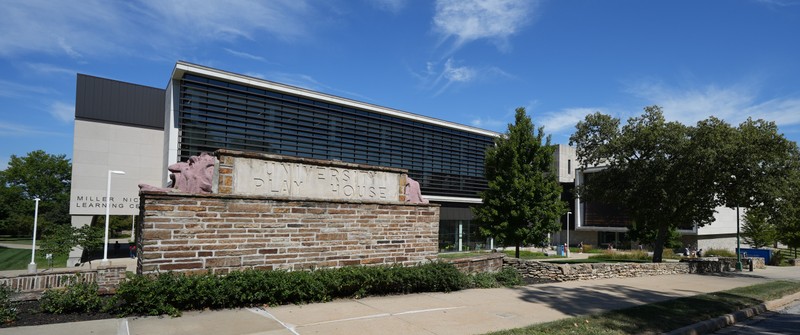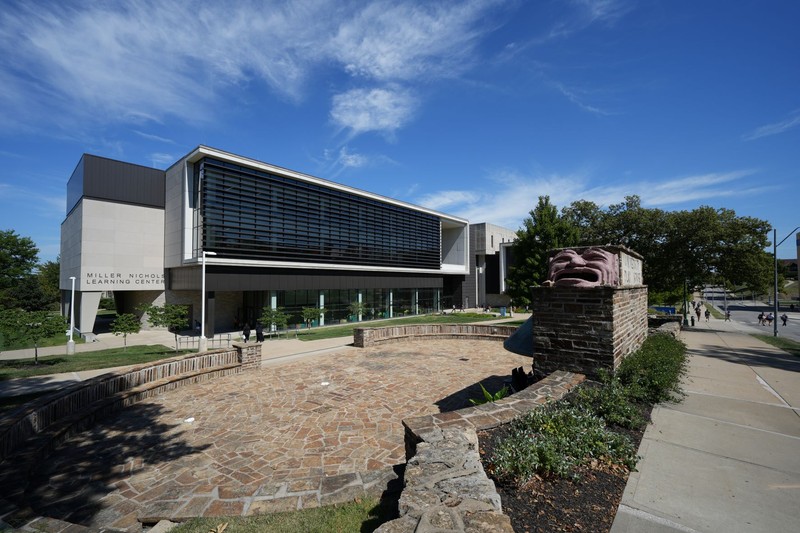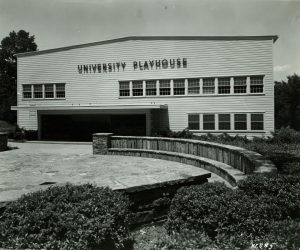UMKC Playhouse (1948-1978)
Introduction
Text-to-speech Audio
Now located between the Swinney Recreation Center and Miller Nichols Library, this campus landmark contain the remains of the University Playhouse. Constructed in 1948, this was the original main campus theatre at the University of Kansas City, a private institution of higher education created by civic leaders in 1933. The organization joined the University of Missouri system in 1963. The Playhouse the result of efforts led by university supporters and theatre connoisseurs Clarence R. and Mary Bell Decker. With support of campus leaders, the university purchased the building from the U.S. Army as war surplus. Prior to being moved to the campus and converted into a theater, the wooden structure previously served as a large auditorium at Camp Crowder in Neosho, Missouri. The building slowly fell into disrepair leading to the administration's decision to demolish the structure in 1978. Today, all that remains is a decorative patio of Arkansas stone, along with a once large fireplace that is now used as decoration for the two intricate ceramic masks representing Comedy and Tragedy. Given its location at between the central quad, library, and student centers, the beloved campus landmark continues to serve some of its original function as a place where students gather and hold social and community events.
Images
Students regularly hold meetings and performances on the University Playhouse patio.

The university playhouse was demolished in 1978 and what remains is the decorative stone

The former campus structure was originally a large auditorium at Camp Crowder

Backstory and Context
Text-to-speech Audio
The University Playhouse at UMKC was a $300,000 project by Clarence R. Decker and his wife Mary Bell Decker. Who both decided a small theatre would be good for the University. The Playhouse was originally a large auditorium at Camp Crowder, but as the war ended it was bought by UMKC and completely redesigned.
The stage was larger than your normal “little theatre” being 98’ x 34’, allowing only 500 seats; the proscenium was 28’ x 18’; the stage was equipped with 28 sets of lines for drops, curtains, and borders; the switchboard and lighting facilities were of recent designs for the time period which were centrally controlled; the stage settings were shifted on “wagons”; the orchestra pit was able to be raised and lowered hydraulically; rooms for costumes, props, and moveable equipment was provided as well. In addition, there were offices and classrooms, a circle-in-the-round theatre, a furnished “Green Room”, and a ten panel painting loaned to the University by Thomas Hart Benton.
Owing to the building's initial design to serve the needs of a military installation, there was no room for a lobby. This led to the decision to create the decorative fireplace at the front of the building along with a patio to offer a space for people to gather before the show and during intermission. The patio was constructed of Arkansas stone and designed by Rick Fillmore to include a large fireplace. One of the masons who helped create the structure referred to the substantial edifice as “a fireplace to end all fireplaces.” The fireplace was designed so that smoke would curl upwards through two sculpted ceramic masks symbolizing Comedy and Tragedy.
It first opened its doors to the public on December 6th, 1948, with a gala performance of Maxwell Anderson’s Elizabeth the Queen. Jane Cowl guest starred in along with Belvins Davis as the guest director. The small theatre became a bustle of action through the years with a tradition of bringing professional actors and directors to come work with the students. One of those actors was Vaugn Burkholder, an actress who had a brief career on Broadway. She adored the theatre and would visit frequently, known for her high heels clicking along the catwalk above the stage. But, on the night of October 23rd, 1957, after she was dropped off at the playhouse, she was greeted by the manager just before she collapsed. She died of a heart attack in the manager’s arms that night. Since then, there had been strange occurrences around the Playhouse. Which only aided in the demise of the building.
After many years of disrepair and the ghost story, the University Playhouse met its end in 1978, the building being demolished and replaced by Olson Performing Arts Theatre which resides on Cherry Street road.
Sources
Decker, Clarence R. Decker, Mary Bell. A Place Of Light: The Story Of A University Presidency. New York. Hermitage House, 1954.
Wolff, Christopher. A Pearl of Great Value: The History of UMKC, Kansas City's University. Kansas City, Missouri. UMKC Alumni Association, 2016.
University Playhouse – brief history, UMKC Today Archives. August 27th 2008. Accessed September 4th 2021. https://info.umkc.edu/news/university-playhouse-brief-history/.
Wolff, Chris. Haunted UMKC: 5 Historically Eerie Locations on Campus, UMKC Today. October 21st 2020. Accessed September 4th 2021. https://www.umkc.edu/news/posts/2020/october/haunted-umkc.html.
Photo by David Trowbridge
Photo by David Trowbridge
